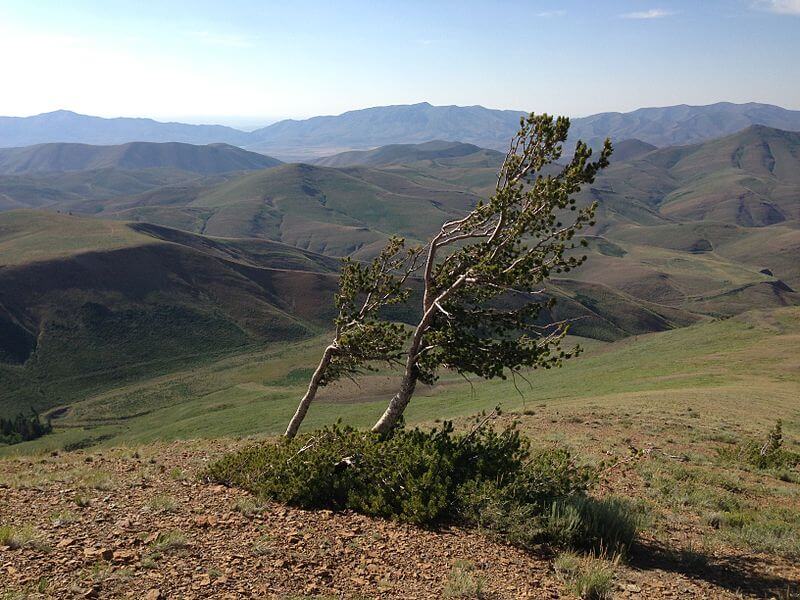Krummholz: Tough Trees at Timberline
By Marina Richie
Broadcast 8.1995, 9.2001, 12.2007, 8.2016, and 8.24 & 8.27.2022

Krummholz whitebark pine, photo by Famartin, CC 2.0.
Listen:
Winds lash the peaks. Snow pelts the ridges almost every month of the year. The warmest average monthly temperature is a mere 50 degrees. The conifer forests of the high Northern Rockies appear hunched, twisted and bent. In fact, there’s a word for the dwarf form of subalpine tree species that in other environs would grow tall and straight: krummholz. Translated from German, it means “crooked wood.”
On a sunny August day, it’s hard to imagine the forces often hammering the subalpine fir, larch, and whitebark pines that dare to push the limits of survival. When Missoula sizzles at 95 degrees, I know I’m not the only one who escapes to alpine coolness. Up high on Sweeney Peak in the Bitterroots one such day, a group of us eat our picnic lunches. We lounge like marmots on lichen-encrusted boulders, where ladybugs crawl and butterflies whisk by in the steady breeze.
Not far below us, subalpine firs and whitebark pines form a creeping mat that reaches just waist high—the krummholz. Like bonsai trees tended intensively by humans, these miniatures have the winds as their attendants. Icy winds dry out new needles and whip branches until they break. The trees’ strategy is to creep low to the ground in a direction away from the gales. In the Bitterroots, winds mostly come from the west and southwest. That’s why you’ll see other subalpine firs with spiky tops rising from the krummholz to a height of 10 feet or so with branches only on the east side. The green needles grow sparsely at the crown, and toward the ground branches sweep into a skirt where snows protect them from ice-blasting. Look for these “flag trees” proclaiming their summit victory.
Along the ridgeline sweeping north-south, whitebark pines stand erect yet savagely twisted. Half of the trees are skeletons, dead not from the winter but from white pine blister rust, a disease brought into this country from Europe on infected white pine seedlings back in the early 1900s. Even in Wilderness peaks, we cannot escape these global influences. The living whitebarks give hope that just as the trees endure the frigid winter temperatures and storms, they can overcome this too.
Why do trees try living up here at all, I wonder? Every step of the way is a struggle, starting with finding a pinch of mineral soil for a seed to take root in among the rocks. It reminds me of the intertidal zones at the ocean. The farther away from the ocean the tougher life becomes, yet for the barnacles, mussels and snails that face a continual danger of drying out, those fewer species also face a lot less competition.
There’s plenty of elbow room up near the top, too, until you reach that demarcation line where trees cannot exist at all. Of course, I love the bald, rocky summits with their 360-degree views. Even here, if you lie down on your stomach, you’ll discover elfin lupine, penstemon and asters rushing to flower, be pollinated and spread their seeds before the relentless snows arrive. My advice for the rest of the summer is to heed the words of John Muir: “Climb the mountains and get their good tidings. The winds will blow their own freshness into you, and the storms their energy, while cares drop away from you like the leaves of autumn.”
Every week since 1991, Field Notes has inquired about Montana’s natural history. Field Notes are written by naturalists, students, and listeners about the puzzle-tree bark, eagle talons, woolly aphids, and giant puffballs of Western, Central and Southwestern Montana and aired weekly on Montana Public Radio.
Click here to read and listen to more Field Notes. Field Notes is available as a podcast! Subscribe on iTunes or wherever you listen to podcasts.
Interested in writing a Field Note? Contact Allison De Jong, Field Notes editor, at adejong [at] montananaturalist [dot] org or 406.327.0405.
Want to learn more about our programs as well as fun natural history facts and seasonal phenology? Sign up for our e-newsletter! You can also become a member and get discounts on our programs as well as free reciprocal admission to 300+ science centers in North America!












